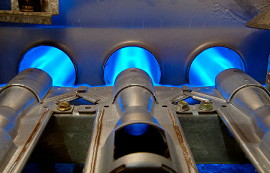Winterizing a home will involve a number of important tasks, such as insulating, filling any air leaks, stopping drafts, covering windows, winterizing outdoor faucets and coiling away the garden hose. The storm drains will need to be checked, the chimney must be clear, and the fireplace inspected. One of the simplest and most overlooked tasks to prepare for winter is to check the furnace. Home safety should always come first, and this is especially true if you have a furnace that runs on natural gas.
If You Have a Modern Furnace Don’t Panic
Safety is important, but it’s important to understand that most modern furnaces have a number of safety switches and features to avoid your home or your health be putting at risk. There is a limit switch that will prevent your system from overheating by shutting it off if the temperature inside the air plenum is too high. The flame sensor will immediately stop the system if there is no flame present to burn the gas. Finally, the air pressure switch can detect if carbon monoxide or other byproducts are incorrectly venting.
Don’t be Complacent About Furnace Safety
Despite these modern furnace features, it’s a good idea to stay vigilant about your furnace safety. With any complex piece of equipment, there is always a chance that a key component can fail. With a natural gas heating system, this could create a fire hazard or even cause a dangerous carbon monoxide leak. These unexpected problems can also be caused by improper installation or accidental damage. In some cases, these problems may remain undetected without professional assistance.
The Importance of Regular Maintenance
A regular maintenance appointment is a must to detect any potential problems early. Early detection can detect a cracked heat exchanger, which is a major cause of carbon monoxide leaks. A heating system that is well maintained is less likely to fail when you need it most and safer to use throughout the heating season.
Use Smoke and Carbon Monoxide Detectors
It’s important to install smoke and carbon monoxide detectors around your home. Carbon Monoxide is an odorless and colorless gas that cannot be detected without the correct equipment. An early indicator may be frequent headaches and/or feeling ill, but a detector will warn you before that becomes a problem. Many people have detectors, but they don’t check them regularly to make sure that they are working. Every month press the button on the detector to check the alarm and change the batteries every six months.
Heating System Replacement
After 10-15 years of faithful use, it’s a good bet that your furnace will not be running as efficiently as it did in the past. Even if your furnace has received regular servicing it will still be more prone to overheating and cracks that could cause a Carbon Monoxide leak. When a furnace is getting too old, it may need more frequent repairs and maintenance, and this is not cost effective. If your heating professional advises you to replace your furnace, it’s a good idea to listen to their advice and install a more efficient modern furnace.
